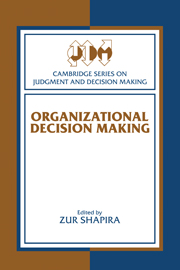Book contents
- Frontmatter
- Contents
- Series preface
- List of contributors
- Editor's preface
- Part I Introduction
- Part II Information processing and attention allocation
- Part III Preference processing
- Part IV Decision processes
- Part V Alternative approaches
- 13 Naturalistic decision making and the new organizational context
- 14 Telling decisions: The role of narrative in organizational decision making
- 15 Bounded rationality, indeterminacy, and the managerial theory of the firm
- 16 The scarecrow's search: A cognitive psychologist's perspective on organizational decision making
- Name index
- Subject index
14 - Telling decisions: The role of narrative in organizational decision making
Published online by Cambridge University Press: 06 August 2010
- Frontmatter
- Contents
- Series preface
- List of contributors
- Editor's preface
- Part I Introduction
- Part II Information processing and attention allocation
- Part III Preference processing
- Part IV Decision processes
- Part V Alternative approaches
- 13 Naturalistic decision making and the new organizational context
- 14 Telling decisions: The role of narrative in organizational decision making
- 15 Bounded rationality, indeterminacy, and the managerial theory of the firm
- 16 The scarecrow's search: A cognitive psychologist's perspective on organizational decision making
- Name index
- Subject index
Summary
When we made the decision, we had already made the decision.
Corporate decision (?) makerOrganizational decision theory and the research that supports it depend largely on narrative: the selective, ordered representation of events as told, the telling of this representation to others, and the successive retellings of this telling. To discover how anything happens in an organization, we ask people to tell us stories. To convince others that we know something about how things happen in organizations, we construct and tell stories about those stories. As others react to our stories, they tell stories about the stories we have told – and so on.
Philosophers (Johnson, 1993; MacIntyre, 1981) argue that narrative is a meaning-making form and process that is central to human experience and conduct. “I can only answer the question ‘What am I to do?’ if I can answer the prior question, ‘Of what story or stories do I find myself a part?’” (MacIntyre, 1981, p. 216). Human conduct is by nature “storied” (Sarbin, 1986): We think, imagine, and choose according to narrative structures. We connect information – random or otherwise – to form patterns and plots. These patterns and plots produce meaning, defined here, according to the literary theory of narrative, as the excess of the “straightforward copy of events recounted” (Barthes, 1982, p. 289). In this chapter, I argue that narrative is a form of human understanding comparable to heuristics in decision theory (Kahneman, Slovic, & Tversky, 1982).
- Type
- Chapter
- Information
- Organizational Decision Making , pp. 304 - 323Publisher: Cambridge University PressPrint publication year: 1996
- 7
- Cited by



